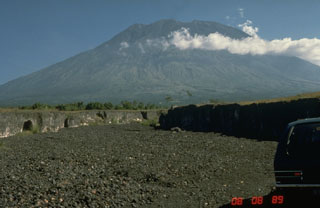Report on Agung (Indonesia) — 13 March-19 March 2019
Smithsonian Institution / US Geological Survey
Weekly Volcanic Activity Report, 13 March-19 March 2019
Managing Editor: Sally Sennert.
Please cite this report as:
Global Volcanism Program, 2019. Report on Agung (Indonesia) (Sennert, S, ed.). Weekly Volcanic Activity Report, 13 March-19 March 2019. Smithsonian Institution and US Geological Survey.
Agung
Indonesia
8.343°S, 115.508°E; summit elev. 2997 m
All times are local (unless otherwise noted)
PVMBG reported that at 1827 on 15 March an explosive event at Agung was recorded for one minute and 23 seconds and produced a dense gray ash plume that rose about 1 km above the crater rim and drifted NNW. Minor ashfall was reported in the villages of Kubu (6 km N), Tianyar (14 km NNW), Ban, Kadundung, and Sukadana. At 0803 on 17 March an event was recorded for 39 seconds and produced a dense gray ash plume that rose about 500 m above the crater rim and drifted E. A second event began at 1030 and lasted about one minute and 16 seconds; a dense gray ash plume rose about 600 m and drifted E. At 0736 on 18 March an ash plume rose 1 km and drifted W and NW. Thermal satellite images continue to indicate hot areas in the crater on the previously-erupted lava surface especially near the flow margins. The Alert Level remained at 3 (on a scale of 1-4) with the exclusion zone set at a 4-km radius.
Geological Summary. Symmetrical Agung stratovolcano, Bali's highest and most sacred mountain, towers over the eastern end of the island. The volcano, whose name means "Paramount," rises above the SE rim of the Batur caldera, and the northern and southern flanks extend to the coast. The summit area extends 1.5 km E-W, with the high point on the W and a steep-walled 800-m-wide crater on the E. The Pawon cone is located low on the SE flank. Only a few eruptions dating back to the early 19th century have been recorded in historical time. The 1963-64 eruption, one of the largest in the 20th century, produced voluminous ashfall along with devastating pyroclastic flows and lahars that caused extensive damage and many fatalities.
Source: Pusat Vulkanologi dan Mitigasi Bencana Geologi (PVMBG, also known as CVGHM)

